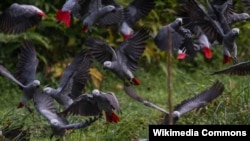The Democratic Republic of Congo contains some of the largest and most diverse rain forests in the world, but in recent decades it has suffered from deforestation and poaching. On December 10, the country celebrated the opening of its first national park since the 1970s.
The rain forest of the Congo Basin is second in size only to the Amazon and spans six African countries. More than half of that area is found in the Democratic Republic of Congo.
On December 10, the DRC celebrated the creation of Lomami National Park, the eighth of its kind in the country, but the first since 1975.
The U.S.-financed Lukuru Foundation launched the project to create the park a decade ago and has worked alongside two provincial governments and the ICCN, a semi-government agency responsible for managing protected areas.
Terese Hart of the Lukuru Foundation spoke to VOA about how the 9,000 square kilometers of Lomami National Park was carved out of the DRC’s interior.
“They started with a very large area, more than 40,000 square kilometers, and they figured that ‘OK this area’s been basically hunted out, this area’s been basically hunted out but this area’s still got a lot of animals," she said. "It’s a very rich and very exciting not only for mammals but also for plants.”
Researching a previously unknown area, they discovered the presence of various rare species endemic to the DRC, such as the okapi, the bonobo and the Congo peacock. They also found about 600 endangered African forest elephants and a new kind of monkey.
VOA asked Hart about the main threats these animals face.
“Really the only threat now in this area is hunting, elephant poaching and commercial bush meat hunting. Those are the threats. So far we’ve been very fortunate in that there’s no gold, no diamonds, no coltan, it’s not a mineral rich area,” she said.
In order to secure the assent of the local population for the creation of the park, five traditional ceremonies known as "Tambiko" were held. Large communities gather to call upon the ancestors they share and to make collective decisions.
“There’s a lot of singing, a lot of dancing. Parts of it we do not see or certainly I as a woman am not allowed to see. There are symbols of the ancestors that are present. It’s very very interesting," said Hart.
Part of African heritage
The park is completely free of human habitation and the partners have established projects to provide alternative livelihoods for the communities on the periphery of the reserve, such as fishponds and employment in the park.
Pastor Cosma Wilungula Balongelwa, the director-general of the ICCN, is positive about the park’s prospects.
In the past, conservation has been the affair of white people, he said, parks have been the business of white people. But today, Balongelwa claims, the Congolese man in the village has understood that the park is his heritage and he is involved in its conservation.
At one point, local politics intervened and the message of harmony was interrupted. A provincial parliamentarian from Tshopo, one of the two provinces in which the park is located, complained that Maniema, the other province involved, benefits disproportionately from the new park.
He said the delegation from Tshopo could not legitimize a state of affairs it finds unacceptable. He then led a walkout, accompanied by the governor of the province, who was sitting on the panel.
The governor of Maniema apologized for the disturbance and concluded stating that the Congolese nation is pleased to offer Lomami National Park to humanity.





